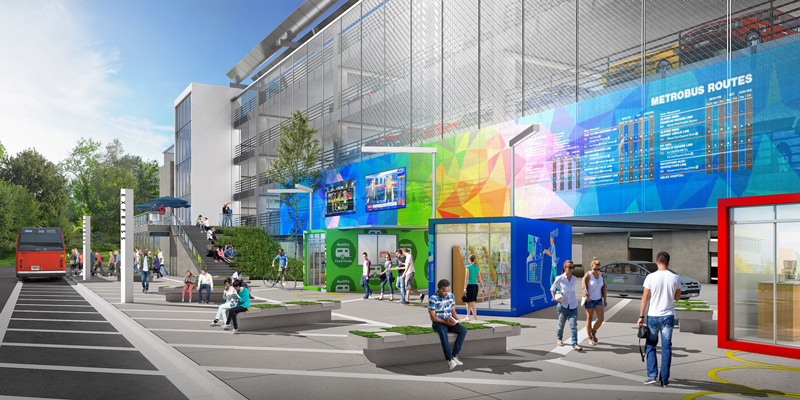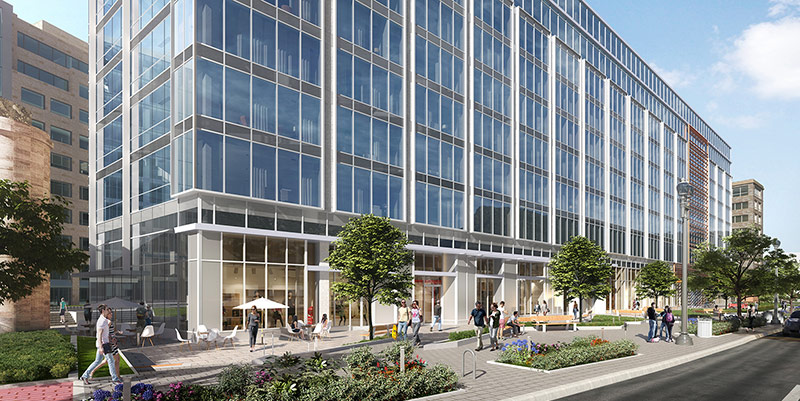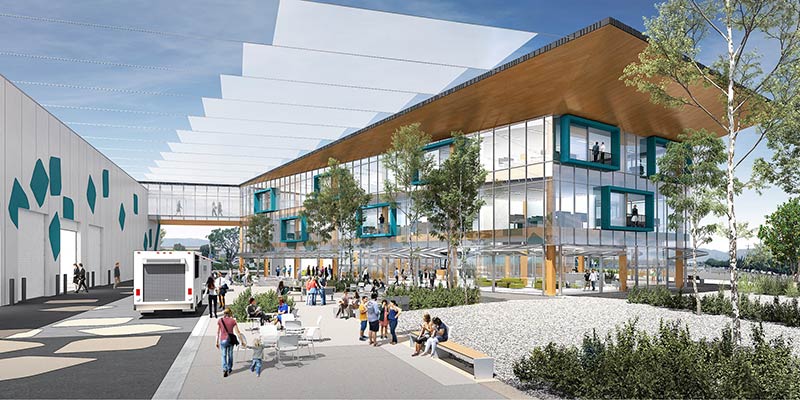Resilient Design – What is resilience?
As cities around the world grapple with a pandemic, climate change and social unrest, resilient design is more important than ever

In this resilient design concept, shipping containers are repurposed to transform a sterile parking garage into a pop-up shopping area and park-and-ride.
This is the first in an ongoing series of articles exploring resiliency in the built environment. Over the next few months, LEO A DALY thought leaders from a wide range of design disciplines will look at resilience through a variety of different lenses seeking a clearer picture of the natural and man-made hazards facing building owners and communities, and what we can do about them.
By Ellen Mitchell-Kozack, AIA, LEED BD+C, WELL AP, SEED, Chief Sustainability Officer
According to the Resilient Design Institute, resilience is the ability to adapt to changing conditions and maintain or regain functionality and vitality in the face of stress or disturbance. It’s the ability to prepare for and bounce back from catastrophic events.
As cities around the world grapple with challenges related to the pandemic, climate change and social unrest, the global conversation about resilience has become more important than ever. Leaders at local and national levels are asking how they can better prevent, prepare for and respond to disasters.
As designers committed to resilient design, LEO A DALY is asking the same questions. The work we do interacts with not only the physical spaces and places that form the fabric of our communities, but with the governments, institutions, businesses and social groups that make them up. We have a duty to understand the threats that face our clients, the complex factors that influence their responses, and the sustainable design strategies necessary to help.
These two images show the same space during two different times of year. Cottage Grove Community Center strengthens community by offering a shared social space and access to civic amenities throughout the seasons.
What’s at stake?
Natural disasters are on the rise around the globe as a result of climate change. In 2020, the world was ravaged by hurricanes, floods and wildfires of record-breaking proportions, all part of a trend that has accelerated in the last 10 years. Global disasters produced $210 billion in losses, according to a report by reinsurance company MunichRe, with $95 billion of that occurring in the U.S.
We must also recognize that man-made disasters pose a threat to the long-term functionality and vitality of communities. Mass shooting incidents are alarmingly common – one per day since 2013 according to Gun Violence Archive. Terrorism, chemical spills and public health crises like the contaminated water in Flint each come with their own toll on communities.
Whether man-made or natural, disasters have a cascade of consequences in the short and long terms. The disaster itself is a point in time; the destruction is high, but duration is brief. Collateral damage, in the way of economic and humanitarian fallout can last years or even decades – people displaced, businesses closed, jobs lost, tax base reduced, insurance premiums increased. The physical losses are important, but the cultural, economic, social and institutional impacts can be just as damaging.
While disasters may seem to affect the rich and poor alike, the issues around environmental justice are more complicated. Poor and minority populations are statistically more likely to be affected by disasters, whether man-made or natural, and less likely to have the resources to deal with it.

20 Massachusetts Ave in Washington, D. C. transforms a monolithic office building into a LEED Gold mixed-use destination. This project drives community resilience by improving sustainability and social cohesion.
How can design help?
While these may seem like overwhelming challenges, design is inextricably intertwined with the ability of communities, ecologies and economies to respond, rebound and regenerate. Below are some basic strategies that planners, architects and engineers should keep in mind on every project.
Be proactive, not reactive
A study by the Rockefeller Foundation found that it cost 50% more to rebuild in the wake of a natural disaster than does to design to withstand it in the first place. That’s the impetus behind the American Institute of Architects placing Design for Change among its criteria for Design Excellence. According to the AIA, good design seeks to address future risks and vulnerabilities from a social, economic and environmental perspective. Not only should projects assess the probability and type of hazards over the service life of a building, but they should consider how they can support immediate recovery and facilitate long-term recovery in the case of crises.
Understand the risks
The vulnerability of a community to natural hazards varies greatly depending on its geography, economic circumstances and social makeup. To help designers, planners, local officials, property owners and others understand these, FEMA worked with dozens of partners in academia and government to create the National Risk Index. This tool helps determine the baseline relative risk of any United States county or census tract for assistance with hazard mitigation planning.
Take a collaborative approach
Design for resilience requires an integrative design process, folding together community, neighborhood, building and infrastructural stakeholders along with a multi-disciplinary core of design professionals. Several rating systems and benchmarking tools have emerged to aid collaborative teams in planning and designing for resilience, including those from RELi, The U.S. Resilience Council, the Resilient Design Institute and LEED. Common to all of these systems is the notion that resilience does not happen in a vacuum. Resilient buildings make up resilient communities, which exist in resilient regions. Embodying this multi-tiered approach is key to designing communities that are shock-resistant and self-reconstructing.
Factor in climate change
Climate change is already observable and will only increase over time. Because of this, climate modeling tools that are based only on historic data will not suffice. We need to be designing for climate conditions 50 years from now.
Some tools have emerged that should be part of any resilient design toolkit. NOAA’s Sea Level Rise Viewer is a web mapping tool that is handy for visualizing community-level impacts from coastal flooding or sea level rise. Risky Business is a good source of research examining the economic risks presented by climate change and opportunities to reduce them. The Intergovernmental Panel on Climate Change is another good source of data and research with an especially good stock of graphical visualizations.

Resilient design strengthens the social fabric, as in this community-centered healthcare concept.
What’s our obligation?
There’s a lot to say about what we could do, but what about what we should do? For that, we can turn to something really basic: the AIA Code of Ethics. When architects in the U.S. join the American Institute of Architects, we subscribe to a code of ethics that takes certain things for granted. According to AIA code E.S. 2.4, Environmental Equity and Justice, we as designers have a responsibility to talk to our clients about climate change and resilient design.
“Members should…make reasonable efforts to advise their clients and employers of their obligations to the environment, including: access to clean air, water, sunlight and energy for all; sustainable production, extraction, transportation and consumption practices; a built environment that equitably supports human health and well-being and is resistant to climate change; and restoring degraded or depleted natural resources.”
That’s a good place to start.
About the author
 Chief Sustainability Officer Ellen Mitchell-Kozack, AIA, LEED BD+C, WELL AP, SEED, leads LEO A DALY’s strategic initiatives in sustainable design worldwide, including Environmental Social & Governance, alignment with the UN Global Compact and Sustainable Development Goals, carbon footprint assessment and social impact. Ellen’s goal is to leverage LEO A DALY’s integrated design expertise to affect positive change. She applies a humanitarian and environmental lens to architecture to benefit clients, the communities we live in and the future of our planet.
Chief Sustainability Officer Ellen Mitchell-Kozack, AIA, LEED BD+C, WELL AP, SEED, leads LEO A DALY’s strategic initiatives in sustainable design worldwide, including Environmental Social & Governance, alignment with the UN Global Compact and Sustainable Development Goals, carbon footprint assessment and social impact. Ellen’s goal is to leverage LEO A DALY’s integrated design expertise to affect positive change. She applies a humanitarian and environmental lens to architecture to benefit clients, the communities we live in and the future of our planet.


